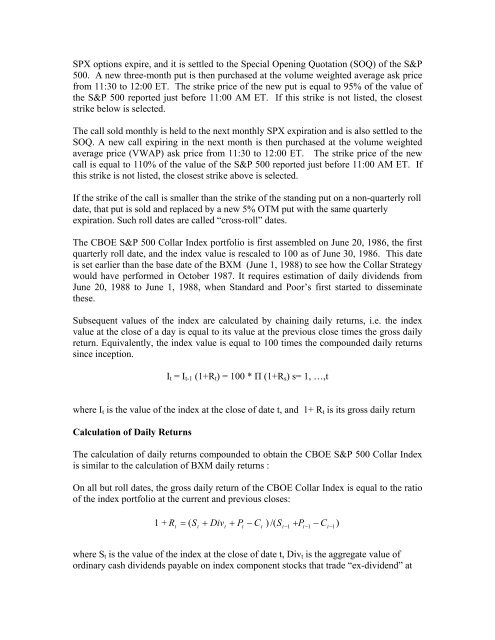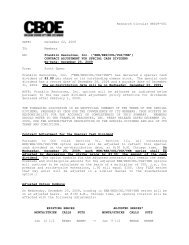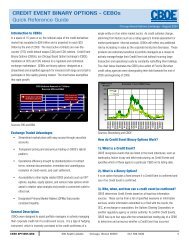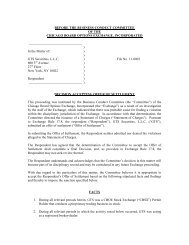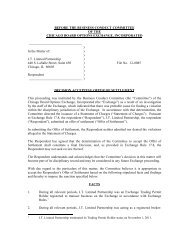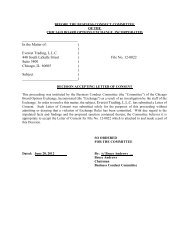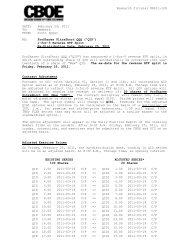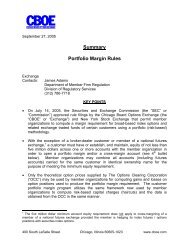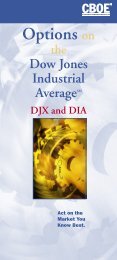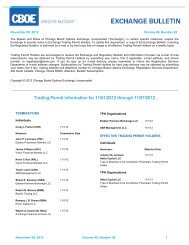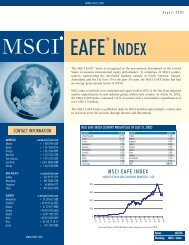CBOE S&P 500 95-110 Collar Index (CLL) - CBOE.com
CBOE S&P 500 95-110 Collar Index (CLL) - CBOE.com
CBOE S&P 500 95-110 Collar Index (CLL) - CBOE.com
Create successful ePaper yourself
Turn your PDF publications into a flip-book with our unique Google optimized e-Paper software.
SPX options expire, and it is settled to the Special Opening Quotation (SOQ) of the S&P<br />
<strong>500</strong>. A new three-month put is then purchased at the volume weighted average ask price<br />
from 11:30 to 12:00 ET. The strike price of the new put is equal to <strong>95</strong>% of the value of<br />
the S&P <strong>500</strong> reported just before 11:00 AM ET. If this strike is not listed, the closest<br />
strike below is selected.<br />
The call sold monthly is held to the next monthly SPX expiration and is also settled to the<br />
SOQ. A new call expiring in the next month is then purchased at the volume weighted<br />
average price (VWAP) ask price from 11:30 to 12:00 ET. The strike price of the new<br />
call is equal to <strong>110</strong>% of the value of the S&P <strong>500</strong> reported just before 11:00 AM ET. If<br />
this strike is not listed, the closest strike above is selected.<br />
If the strike of the call is smaller than the strike of the standing put on a non-quarterly roll<br />
date, that put is sold and replaced by a new 5% OTM put with the same quarterly<br />
expiration. Such roll dates are called “cross-roll” dates.<br />
The <strong>CBOE</strong> S&P <strong>500</strong> <strong>Collar</strong> <strong>Index</strong> portfolio is first assembled on June 20, 1986, the first<br />
quarterly roll date, and the index value is rescaled to 100 as of June 30, 1986. This date<br />
is set earlier than the base date of the BXM (June 1, 1988) to see how the <strong>Collar</strong> Strategy<br />
would have performed in October 1987. It requires estimation of daily dividends from<br />
June 20, 1988 to June 1, 1988, when Standard and Poor’s first started to disseminate<br />
these.<br />
Subsequent values of the index are calculated by chaining daily returns, i.e. the index<br />
value at the close of a day is equal to its value at the previous close times the gross daily<br />
return. Equivalently, the index value is equal to 100 times the <strong>com</strong>pounded daily returns<br />
since inception.<br />
I t = I t-1 (1+R t ) = 100 * П (1+R s ) s= 1, …,t<br />
where I t is the value of the index at the close of date t, and 1+ R t is its gross daily return<br />
Calculation of Daily Returns<br />
The calculation of daily returns <strong>com</strong>pounded to obtain the <strong>CBOE</strong> S&P <strong>500</strong> <strong>Collar</strong> <strong>Index</strong><br />
is similar to the calculation of BXM daily returns :<br />
On all but roll dates, the gross daily return of the <strong>CBOE</strong> <strong>Collar</strong> <strong>Index</strong> is equal to the ratio<br />
of the index portfolio at the current and previous closes:<br />
1 + R S + Div + P − C ) /( S + P − C )<br />
t<br />
= (<br />
t t t t t−1 t−1<br />
t−1<br />
where S t is the value of the index at the close of date t, Div t is the aggregate value of<br />
ordinary cash dividends payable on index <strong>com</strong>ponent stocks that trade “ex-dividend” at


